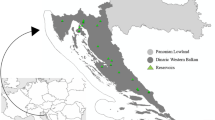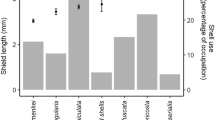Summary
Unionicolid water mites inhabit freshwater unionid mussels during the nymphal and adult stages of their life-cycle. Regular sampling of mussels from two sites in St. Mark's River, Fl. established that each of four species of water mite (Unionicola abnormipes, U. fossulata, U. serrata and U. formosa) occurred mainly in one or two of the mussel species available at each site.
The role of preference for particular mussel species during host location was assessed for the first three mite species by choice experiments, in which mites were offered different mussel species simultaneously. In five out of six experiments, mites entered normally unused mussels as often as they did normally used ones. Additionally, a sexual difference in choice was found for U. fossulata, with males preferring one mussel species and females showing no preference. One mussel species, (Anodonta imbecilis), normally unused but chosen by mite species during the lab. experiments, is inhabited exclusively by the fourth mite species, U. formosa, in the field. An experiment showed that U. formosa excludes other mite species aggressively from Anodonta imbecilis.
The results illustrate the sometimes misleading nature of simple sampling data as an indication of host specificity or host preference in parasites. They suggest also that the population dynamics of some parasites might be more fruitfully compared to unrelated, free-living species than to other parasites.
Similar content being viewed by others
References
Baker RA (1977) Nutrition of the mite Unionicola intermedia Koenike and its relationship to the inflammatory response induced in its molluscan host Anodonta anatina L. Parasitology 75:301–308
Bober CM, Dick TA (1983) A comparison of the biological characteristics of Trichinella spiralis var. pseudospiralis between mice and bird hosts. Can J Zool 61:2110–2119
Boxshall GA (1976) The host specificity of Lepeophtheirus pectoralis (Muller, 1766) (Copepoda: Caligidae). J Fish Biol 8:255–264
Connell JH (1985) The consequences of variation in initial settlement vs post-settlement mortality in rocky intertidal communities. J Exp Mar Biol Ecol 19:11–45
Dimock RV (1983) In defense of the harem: Intraspecific aggression by male water mites (Acari: Unionicolidae). Ann Entomol Soc Am 76:463–465
Dobson AP (1985) The population dynamics of competition between parasites. Parasitology 91:317–347
Fingleton B (1984) Models of category counts. Cambridge Univ Press, London
Halvörsen O (1976) Negative interaction amongst parasites. In: Kennedy CR (ed) Ecological aspects of parasitology. North-Holland, Amsterdam, pp 99–114
Holland C (1984) Interactions between Moniliformis (Acanthocephala) and Nippostrongylus (Nematoda) in the small intestine of laboratory rats. Parasitology 88:303–315
Holmes JC (1973) Site selection by parasitic helminths: interspecific interactions, site segregation, and their importance to the development of helminth communities. Can J Zool 51:333–347
Holmes JC (1976) Host selection and its consequences. In: Kennedy CR (ed) Ecological aspects of parasitology. North-Holland, Amsterdam, pp 21–39
Jones RKH, Baker RA (1984) Descriptions of unionicolid larvae from three North American unionid bivalves. Hydrobiologia 114:109–113
Kearn GC (1973) An endogenous circadian hatching rhythm in the monogenean skin parasite Entobdella soleae, and its relationship to the activity of the host (Solea solea). Parasitology 66:101–122
LaRochelle PB, Dimock RV (1981) Behavioral aspects of host recognition by the symbiotic water mite Unionicola formosa (Acarina: Unionicolidae). Oecologia (Berlin) 48:257–259
Lim HK, Heyneman D (1972) Intramolluscan intertrematode antagonism: A review of factors influencing the host parasite system and its possible role in biological control. Adv Parasitol 10:191–268
MacDonald S (1975) Hatching rhythms in three species of Diclidophora (Monogenea) with observations on host behaviour. Parasitology 71:211–228
Millott SM, Cox FEG (1985) Interactions between Trypanosoma brucei and Babesia spp. and Plasmodium spp. in mice. Parasitology 90:241–254
Minchella DJ (1985) Host life-history variation in response to parasitism. Parasitology 90:205–216
Mitchell RD (1955) Anatomy, life-history, and evolution of the mites parasitizing fresh-water mussels. Misc Publ Mus Zool Univ Michigan No 89
Mitchell, RD (1965) Population regulation of a water mite parasitic on unionid mussels. J Parasitol 51:990–996
Noble ER, Noble GA (1976) Parasitology. 4th ed Lea & Febiger, Philadelphia, USA
Paperna I (1964) Competitive exclusion of Dactylogyrus extensus by Dactylogyrus vastator (Trematoda, Monogenea) on the gills of reared carp. J Parasitol 50:94–98
Price PW (1980) Evolutionary biology of parasites. Princeton Univ Press, Princeton, New Jersey
Rohde K (1979) A critical evaluation of intrinsic and extrinsic factors responsible for niche restriction in parasites. Am Nat 114:648–671
Rohde K (1982) Ecology of marine parasites. Univ Queensland Press, St. Lucia, Australia
Scott ME, Robinson MA (1984) Challenge infections of Gyrodactylus bullatarudis (Monogenea) on guppies Poecilia reticulata (Peters), following treatment. J Fish Biol 24:581–586
Sokal RR, Rohlf FJ (1981) Biometry. 2nd ed WH Freeman, New York
Vidrine MF (1980) Systematics and coevolution of unionicolid water mites and their unionid mussel hosts in the eastern United States. PhD Thesis, Univ Southwestern Lousiana, p 661
Vidrine MF (1983) Verification of oviposition sites of two watermites in the subgenus Polyatax (Acari: Unionicolidae: Unionicola). Bull Assoc Southeast Biol 30:89
Vogel S (1981) Life in moving fluids: The physical biology of flow. Princton Univ Press, New Jersey
Wakelin D (1976) Host responses. In: Kennedy CR (ed) Ecological aspects of parasitology. North-Holland, Amsterdam pp 115–141
Whitfield PJ (1979) the biology of parasitism: An introduction to the study of associating organisms. Edward Arnold, London
Wilson CB (1916) Copepod parasites of fresh-water fishes and their economic relation to mussel glochidia. Bull US Bur Fish 34:131–374
Wilson DS (1982) Genetic polymorphism for carrier preference in a phoretic mite. Ann Entomol Soc Am 75:293–296
Winer BJ (1971) Statistical principles in experimental design. McGraw-Hill Kogakusha, Sydney Australia p 907
Author information
Authors and Affiliations
Rights and permissions
About this article
Cite this article
Downes, B.J. Guild structure in water mites (Unionicola spp.) inhabiting freshwater mussels: choice, competitive exclusion and sex. Oecologia 70, 457–465 (1986). https://doi.org/10.1007/BF00379512
Received:
Issue Date:
DOI: https://doi.org/10.1007/BF00379512




